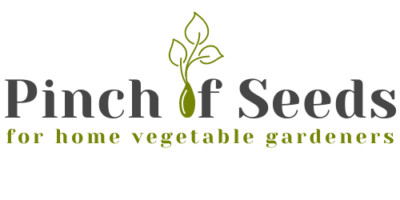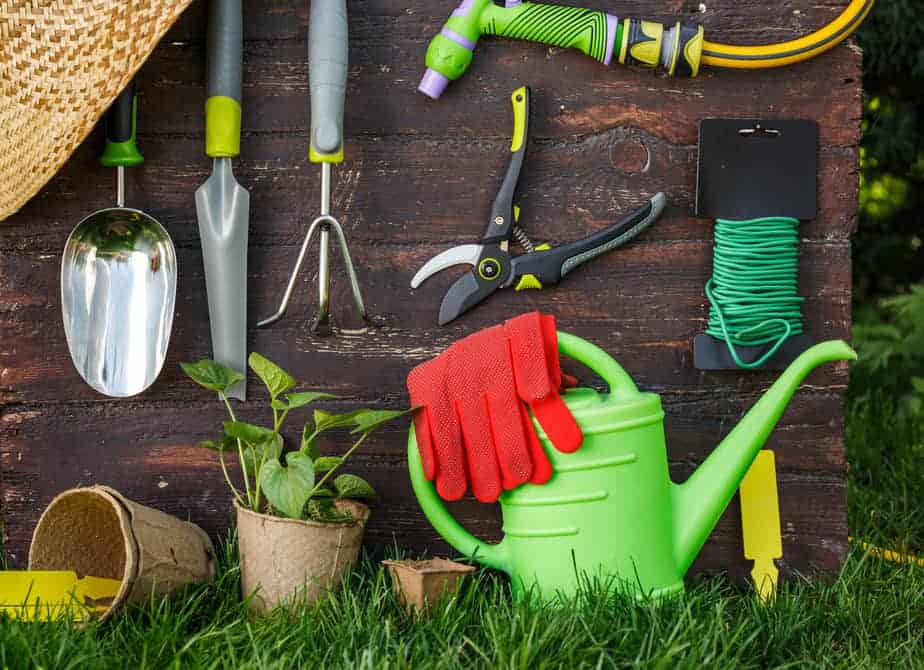No matter what you are going to plant in your balcony or patio container garden, there are a bunch of gardening tools you should always keep handy. They just make gardening tasks to take care of potted plants much easier.
So what are the most essential tools for container and elevated planter gardening? The most basic tools for container gardening are a trowel, a hand cultivator, a pruner, a pair of hand gloves and a watering can. Once you get started, you may also want a kneeling pad, soil scoop, pointed scissors, various plant supports, and plant labels.
You might wonder what these tools are, when and how to use them and things to consider when buying them. Let me explain.
Must have Garden Tools:
1. Hand Trowel

This tool looks like a miniature version of a garden spade. It is the most useful tool of all. It is used for mixing soil, digging a hole, transplanting seedlings, leveling out soil and dividing tubers. It can also be used for scooping out compost or potting mix from the bag.
Things to consider when buying: Make sure the spade part is made of a heavy metal like carbon steel, iron or steel, so it doesn’t bend easily. Trowel made of aluminum might be cheaper up front, but it will last you a couple of seasons. Some variation of this tool comes with inch markings on the inside, which makes it very easy to dig a hole of a precise depth for planting tubers. Make sure the grip of the tool is comfortable in your hand. Look for ergonomic hand grip with rubber coating. And having a loop at the end of the handle for easy hanging is very handy!
2. Hand cultivator

This tool has three or more prongs at one end with a hand grip on the other end. It is used for raking and tilling the container soil, taking out weeds and mixing the slow release fertilizers with the potting soil.
Things to consider when buying: Just like a trowel, make sure the prongs are made of heavy metal, so they don’t bend easily. The grip of the cultivator should be comfortable and non-sleepy in your hand. A hanging hole at the end of the grip is desirable for easy organization. My favorite is Dewit 5-Tine Cultivator with short handle.
3. Pruner

It is also known as Garden Shears or bypass pruner. It is used to cut woody stems and small branches. I use this to harvest eggplants, bell peppers, and tomatoes from the plants.
Things to consider when buying: The most important thing to look for in pruner is sharp blades. Mach sure the blades are rust proof and don’t require frequent sharpening. Having the ability to lock the pruning blades will also help prevent any accidental injuries. For container gardening, you won’t need more than ⅝ inch cutting diameter capacity.
4. Gardening Gloves

The is just the basic necessity to prevent your hands from becoming muddy or your nails looking like a zombie. I like to buy multiple pairs of inexpressive garden gloves, so I always have back up when one pair is missing or in the washer.
Things to consider when buying: If you are allergic to certain plants like eggplants or okra, or have sensitive skin, buy long sleeve garden gloves. If you are going to take care of container roses, buy thornproof gloves.
5. Watering Can

Unless you have a water hose connection nearby where you want to garden, you will need a watering can to water your plants.
Things to consider when buying: Watering cans come in all different shape, size, and material. Pick one that is between 1 to 3-gallon capacity, not too heavy in weight and have a long reach spout. It also worth to see how the grip and feel are when you tip over the watering can. Think about how you are going to water the potted plants. Are you going to fill the bottom reservoir of a self-watering container? Then long reaching spout with a small tip is essential. If you are going to over water small seedlings and plants, watering can with a shower head is better.
6. Kneeling Pad

This bouncy little rubber platform makes it so easy to work on the floor. You can rest your knees on this while tending your container or just use it as a cushion to sit on – either way, it is one of the items you will be thankful for buying.
Things to consider when buying: Make sure to the pad is made of a flexible, sponge-like material that is comfortable to sit on and is waterproof. If you really want to splurge, look for the kneeling pads that can double as a seating stool when flipped! You will be glad you spent the extra $$ for this convenience!
Money Saving Tip: An old outdoor throw pillow makes a great, thick garden keeling pad!
7. Soil Scoop
This is quite similar to pet food scoop. It is used for shoveling soil, fertilizer, compost, etc. from a bag to the container.
Things to consider when buying: Look for large scooping capacity with higher side walls. It makes it easy to transfer large volume in one shot. Also, make sure it is made of rustproof material like steel or plastic.
8. Micro-tip Scissors

This is small scissors with pointed blades. It comes quite handy in thining out home grown seedlings and snipping off leaves and flowers with more precision than pruner. This is what I use for pruning tomatoes suckers.
Things to consider when buying: Look for sharp, pointed blades made with rust proof material like steel or titanium. Some models come with a locking mechanism to prevent accidental misuse.
9. Plant Supports

Container gardening means taking advantage of vertical space as much as possible. If you are growing tomatoes in the pot, having a sturdy cage or stake is essential. Vegetables like peppers, and eggplants in a container will also require stacking and support later in the season to prevent them from falling over. Vining crop like beans and peas will need a trellis to go up. By using cages, you can train squash and melons to grow vertical. Having twine and ties is also handy in supporting container plants.
Things to consider when buying: When buying plant supports, there are plenty of options to choose from. Round and square cages, bamboo and coated steel stakes, different shapes of rings and half rings… you get the point. No matter what you pick, make sure they are made of sturdy material which will not bend, rust or break easily.
10. Plant Labels

Once you have multiple plants and multiple varieties of the same plant, you would want to remember which is which. Plant labels can help you remember the name and the variety of the plant and the date of the transfer in the container. This is especially helpful if you want to keep a garden journal.
Things to consider when buying: Make sure the labels allow to write with waterproof and fade-proof ink. Wooden labels will rot and decompose after a while. There are options available to buy metal labels and carve plant names on it. You could make your own plant labels by painting on river rocks!
How to organize Garden Tools:
Whenever I step out in the garden, I always have my trusted companion with me- my garden tool bag. It’s such a convenience to just grab the Garden Tool Bag and step out of the patio door! Along with the hand tools, I always have a few plastic bags to gather the waste and compost material, a water bottle and some paper towels in my gardening tool bag.
How to care for your gardening tools:
- Clean hand tools promptly after each use by rinsing in the water. Wipe the tools with rag or paper towel, or hang them to air dry.
- Clean plant supports at the end of the season.
- Once a month, sanitize gardening hand tools by wiping off with alcohol wipes or by soaking them in mild bleach water for 10 minutes.
- Sharpen pruner and scissor blades every few months.
- Wipe pruner and scissor bladed with WD-40 to lubricate them.
- Store all the gardening tools indoor in a garage or shed. Leaving the tools out in the open will decrease their usability.
3 Cool and Useful Tools for Container Gardening:
Here is a list of tools that are not must-haves but they are so cool, they are worth mentioning.
1. Soil Moisture Meter:

This little one or two-pronged device keeps track of moisture in the soil. It readily shows you if the container needs another watering. If you are prone to under water or over water your plants, this is for you!
2. Self-watering spikes:

This watering spike turns a regular drinking water bottle or a wine bottle into a slow releasing drip system. Put one of these spikes on a water-filled bottle, turn it upside down, and insert the spike into the container, close to the plant- viola! You don’t need to worry for a few days! If you travel a lot or frequently forget to water your container tomatoes, this device is for you!
3. Plant Dolly:

It looks like a plant platform with wheels! It makes it easier to move the heavy containers around to chase sunlight or away from adverse weather. You may want to consider this if you are a senior or have back issues.
Conclusion:
Over the years, I have tried and tested many different gardening tools, but some have a permanent place in my tool bag. Same will happen to you too. There will be some tools you can’t imagine being without when gardening. Have you found those? What are they? Please share your thoughts!

